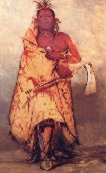
Omaha
Literature
"Do not grieve. Misfortunes will happen to the wisest and best of
men. Death will come, always out of season. It is the command of the
Great Spirit, and all nations and people must obey. What is past and
what cannot be prevented should not be grieved for.... Misfortunes do
not flourish particularly in our lives -- they grow everywhere."
Chief Big Elk, Omaha
"I shall vanish and be no more, but the land over which I now roam
shall remain and change not."
Omaha Warrior Song
History
of Omaha Indian tribe
Omaha Indian
Music
Omaha
Tribal Council
The
Omaha Tribe
Joseph
LaFlesche (Iron Eye) (ca 1820-1888)
Omaha tribal chief
The Indian name of
Joseph LaFlesche, also known as Iron Eye, was
E-sta-mah-za. LaFlesche, the son of a Frenchman and a woman of
the Ponca tribe, was the adopted son of Chief Big Elk, the
First,
of the Omahas. He was selected by Big Elk to be his successor as
chief. LaFlesche's policy, favoring civilization and education
for the Omaha tribe, was met with disapproval by the Omahas. He
brought about the elimination of intemperance among tribal
members during his rule. Even though he was trusted and
respected, the time he was chief of the Omahas was filled with
strife.
Visualizing that
white people would soon populate the Plains
region, LaFlesche advocated the tribe's peaceful cohabitation of
the Plains by their becoming farmers and by their seeking
education for their children. Though he had no formal education,
and could not speak English, nor read or write, LaFlesche wanted
his people to have the rights citizenship would bring, and also
to own land individually by patent.
LaFlesche was the
last be to made chief under the old Omaha
rituals. As mediator between the Omaha tribe and the government,
he tried to ease the Omaha's way into the new society in which
they found themselves.
LaFlesche was
married twice, first to Mary,the daughter of Dr.
John Gale and Nicomi, a woman of the Iowa tribe. His second wife
was Tainne of the Omaha tribe. He was the father of several
children, among them Susette (Bright Eyes) Tibbles, Susan
Picotte, who was a physician, and Francis LaFlesche, who was an
author in Washington, D. C.
Susan
La Flesche Picotte 1865 -- 1915
Physician, tribal leader; born on the Omaha reservation in Nebraska.
Daughter of Omaha Chief Joseph La Flesche (Iron Eye), she was educated
in New Jersey and then at the Hampton Institute (Va.), graduating in
1886 with high honor. She then studied at the Women's Medical College
of Pennsylvania, graduating in 1889, and returned to her tribe as a
physician (1890--94) and all-around medical overseer. In 1894 she
married Henry Picotte (half Sioux, half French) and they moved to
Bancroft, Nebr., where she continued her medical practice while raising
two children. With the founding of the town of Walthill in the Omaha
reservation, she became so active in community and child affairs, as
well as a medical doctor, that she was effectively the leader of the
Omahas. The hospital she founded (1913) was named after her upon her
death.
Susette
La Flesche Tibbles, (originally Inshtatheumba, "Bright Eyes")
1854 -- 1903
Omaha reformer, author, and illustrator, born in present-day Nebraska,
USA (sister of Susan La Flesche Picotte). Both grandfathers were
Caucasians, both grandmothers were Native Americans; her father was an
Omaha chief, her mother was more involved with the world of whites.
After studying at a girls school in Elizabeth, NJ, Susette returned to
the reservation and became a teacher in a government school. In an
infamous affair in its day, the Ponca Indians were forcibly removed
from their lands in 1877; in the national protest that followed,
Susette La Flesche travelled to the East as translator for the Ponca
chief, Standing Bear, on a lecture tour organized by an Omaha
newspaperman, Thomas Tibbles. (She coauthored, with Standing Bear,
Ploughed Under: The Story of an Indian Chief, 1882.) She and Tibbles
were married in 1881 and their crusade led to the passage of the Dawes
Act of 1887. The Tibbles also travelled to England to present the case
for Native Americans' claims to their land. Thereafter she lectured
occasionally, wrote various articles, and gained a minor reputation as
an artist-illustrator. She and her husband lived most of their years in
Nebraska where she died on her native land.
 Return to
Indigenous Peoples' Literature
Return to
Indigenous Peoples' Literature
Compiled by: Glenn Welker
This site has been accessed over 10,000,000 times since February 8,
1996.

 Return to
Indigenous Peoples' Literature
Return to
Indigenous Peoples' Literature